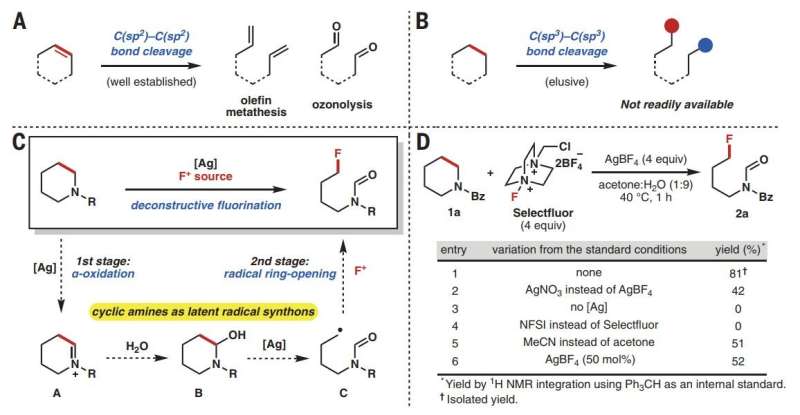July 16, 2018 report
Silver salt used to break C鈥揅 bonds in unstrained cyclic amines

A team of researchers at the University of California has found a way to break C鈥揅 bonds in unstrained cyclic amines using silver salt. In their paper published in the journal Science, the group describes the technique they developed and how well it worked.
In the world of chemists, the goal is quite often to instigate the creation of bonds to hold molecules together in useful ways. Such bonds form the basis of new materials such as drugs for treating human ailments. But as has been often noted, before creating new bonds, old ones must often be broken. One of the most notorious bonds that need to be broken are carbon-carbon bonds. Double C鈥揅 bonds are typically easy to functionalize; it is the inert C鈥揅 single bonds that give chemists so much trouble. But that might be changing, as the researchers with this new effort claim they have developed a simple and straightforward technique to do the job. They even suggest it is ready for pharmaceutical or other biological applications.
The technique involves breaking C鈥揅 bonds in nitrogen-containing rings. An amount of silver salt along with a dose of a fluorinating reagent (an electrophilic fluorine) is introduced. The researchers explain that the resulting reactions starts with the silver first oxidizing the 伪 carbon that lies just next to the nitrogen. That is followed by a radical mechanism involving the 尾 carbon ring-opening fluorination. Afterward, a chain results with a fluorine atom at one end of a chain. The researchers note that in some instances, the technique can also be used to cause a formyl group to wind up on the other end of the chain.
The researchers report that they tested their technique by using it to open several four-membered rings鈥攁ttempts to do so with five-membered rings resulted in oxygenated rings. They also found it could be used for ring-opening with fluorination of peptides.
The group reports that they have plans to continue their research with the technique and hope to find a way to achieve the same results while lowering the metal content involved.
More information: Deconstructive fluorination of cyclic amines by carbon-carbon cleavage, Science 13 Jul 2018: Vol. 361, Issue 6398, pp. 171-174, ,
Abstract
Deconstructive functionalizations involving scission of carbon-carbon double bonds are well established. In contrast, unstrained C(sp3)鈥揅(sp3) bond cleavage and functionalization have less precedent. Here we report the use of deconstructive fluorination to access mono- and difluorinated amine derivatives by C(sp3)鈥揅(sp3) bond cleavage in saturated nitrogen heterocycles such as piperidines and pyrrolidines. Silver-mediated ring-opening fluorination using Selectfluor highlights a strategy for cyclic amine functionalization and late-stage skeletal diversification, establishing cyclic amines as synthons for amino alkyl radicals and providing synthetic routes to valuable building blocks.
Journal information: Science
漏 2018 麻豆淫院




















